|
January 1963 Electronics World
 Table
of Contents
Table
of Contents
Wax nostalgic about and learn from the history of early electronics. See articles
from
Electronics World, published May 1959
- December 1971. All copyrights hereby acknowledged.
|
If you have been searching
for a do-it-yourself VLF loop antenna that can be resonated from approximately 14
to 25 kHz, then look no more. This article from a 1963 edition of Electronics
World magazine presents a relatively simple to build job that reportedly provides excellent
reception. At these frequencies a wavelength is measured in miles, which makes even
a simple dipole antenna impractical, so the multi-turn loop is the only
reasonable alternative for most people.
It is the same principle that allows the little ferrite-core antenna inside your
AM radio to work so well when the shortest wavelength in the commercial AM broadcast
band (535 - 1700 kHz in the U.S.) is nearly 600 feet.
V.L.F. Loop Antenna
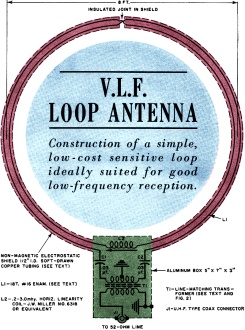
Fig. 1 - Schematic of loop with its tuning and matching
network.
By Richard A. Genaille
Construction of a simple, low-cost sensitive loop ideally suited for good low-frequency
reception.
The very-low frequencies from 3 to 30 kilocycles have experienced a resurgence
of use and interest about which many persons engaged in electronics are not aware.
The September, 1961 issue of this magazine carried an article ("Below the Broadcast
Band") in which the author described some of the activities which are taking place
in the very-low and low-frequency bands and also a simple low-frequency converter
which could be constructed for the reception of these frequencies. Briefly, the
very-low frequencies are providing a means of high-accuracy frequency determination
in much shorter periods of time than is normally possible on the higher frequencies,
and also the means by which the U. S. Navy transmits messages to submerged submarines
which are scattered throughout the oceans of the world. Present and proposed activities
relative to the v.l.f. region will be discussed later in this article.
So fascinating and useful have the very-low frequencies become that the author
decided to upgrade his receiving antenna system for v.l.f. by constructing a loop
antenna which would greatly improve signal-to-noise ratio and would discriminate
against adjacent-channel interference. A considerable amount of experimentation
produced a v.l.f, loop antenna that, you will discover, is simple to construct,
efficient and inexpensive, and which has all of the desirable electrical features
that a loop antenna should have. While the loop to be described was constructed
for use in conjunction with the low-frequency converter featured in the aforementioned
article, it has been designed with a feed-point impedance of 52 ohms to accommodate
standard 52-ohm coaxial transmission line and the input impedance of some receivers.
It may be used on other very-low frequency converters or receivers having other
than a 52-ohm input impedance by the simple expedient of impedance matching. Since
receiver input impedances can vary considerably, the author will describe the method
used to impedance-match to his converter as well as several simple methods of matching
to other input impedances.
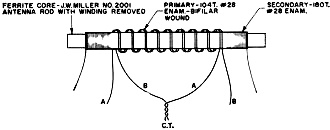
Fig. 2 - Construction of the bifilar-wound balanced transformer.

Fig. 3 - Bridge method of measuring s.w.r. when tuning antenna.
The decision to construct a loop antenna for v.l.f, in preference to using a
random length long wire or a simple half-wave dipole was made after realizing that
such antennas have several undesirable characteristics. Providing that the long
wire was made long enough to have definite directional characteristics, it would
be quite difficult to make use of the directional features because of the problem
of positioning the antenna. The long wire is inferior to a loop antenna for minimizing
noise pickup. A simple half-wave dipole at 20 kilocycles would be approximately
4 miles long. To keep the v.l.f. antenna to a reasonable size and to provide directional
selectivity and noise reduction were factors which led to the choice of the loop
antenna as the most satisfactory solution to the antenna problem.
Since loop antennas are not as commonplace as the "garden variety" of directional
antennas, such as multi-element directive arrays for amateur radio and TV use, a
few words regarding loop antenna operation may be in order for a better understanding
of the constructional details to follow.
Loop-Antenna Operation
Loop antennas have been widely used for many years in direction finding systems
particularly aboard aircraft and vessels. The function of the loop is to sense the
direction of the arrival of radio signals emanating from a transmitter at a fixed
location. The basic loop antenna is simply a coil of wire whose diameter is small
in comparison to the wavelength to which the coil is tuned. The ground-wave transmission
from the very-low frequency station causes vertically polarized waves to induce
voltages in the loop wire as these waves pass by the loop. The induced voltages
in the loop wire produce a loop current which depends upon the positioning of the
loop antenna with respect to the wavefront.
Almost any convenient shape can be used for a loop antenna, such as a square,
triangle, octagon, or diamond. But regardless of which shape the loop assumes, the
maximum directivity is along the plane of the loop with a distinct minimum or null
at right angles to the plane. The directive pattern of a loop whose diameter is
small with respect to the wavelength to which the loop is tuned is similar to that
of a doublet antenna, that is, a figure-8 field pattern. The minimum or null, which
is broadside to the plane, is extremely sharp in a well-designed loop antenna and
is normally capable of giving bearing information better than one degree in low-frequency
direction finding work.
While the purpose of constructing the loop antenna, in this case, is not that
of direction finding, the presence of a sharp null at zero and 180 degrees with
respect to a fixed v.l.f. signal source a reasonable distance away indicates that
the loop is functioning properly. This will make it possible for us to eliminate
undesirable adjacent-channel interference. The absence of this sharp null broadside
to the plane of the loop antenna can be caused by locating the antenna too close
to power wires, other antennas, gutters and downspouts, or other metallic objects
and, in general, by poor symmetry of the entire loop antenna circuit including the
transmission line and receiver input. The use of a balanced feedline arrangement
and a push-pull r.f. stage for the receiver input or a suitable-matching transformer
to match between a balanced feed point and an unbalanced line can be accomplished
to improve loop circuit symmetry.
Static electricity in the air is a source of much noise in low-frequency reception
and very often causes complete masking of desired signals. Enclosing the receiving
loop wires in a non-magnetic metallic shield will greatly reduce noise pickup thereby
enhancing the over-all signal-to-noise ratio of the receiving system. The loop wires
are completely surrounded by the shield except for a narrow transverse gap or break
at the apex of the loop electrostatic shield.
Circuit Arrangement
The v.l.f. loop antenna shown in the photograph can be resonated from approximately
14 kc. to 25 kc. with the components specified in the schematic diagram. In this
range the feed point impedance will be 52 ohms. The construction of this antenna
is quite simple and straightforward and the cost of the materials used represents
a very small investment of the performance obtained. All of the component parts
of the loop antenna circuit are readily available.
The schematic of the v.l.f. loop is shown in Fig 1. L1 is continuous loop made
up of 18 turns of #16 enameled or form-var-insulated wire. L2, which is adjustable
from 0.2 to 3 mhy, is used to resonate the loop circuit to the desired frequency.
T1 is a matching transformer wound so that loop balance is maintained while providing
a match to a 52-ohm unbalanced line. Capacitors C1 and C2 are good quality micas
used to bring the over-all loop tuning into the range of tuning coil L2. The tuning
coil, capacitors, and matching transformer are housed in an aluminum box with dimensions
of suitable size to permit freedom in making the necessary connections.
The electrostatic shield for the loop wires is made from a twenty-five foot length
of soft-drawn copper tubing with a 1/2-inch inside diameter. This tubing is available
from Sears, Roebuck or any plumbing supply house. In many cases 25 feet of tubing
represents a standard length coil and was chosen so as to avoid wasted tubing due
to cutting. A length of cheap plastic hose with a 3/8-inch i.d. and slightly less
than a 1/2-inch o.d. was used inside the copper tubing to protect the loop wires
during the pulling operation. The author felt that the small extra cost of the plastic
hose would be worth it to prevent possible abrasion of the wire insulation and subsequent
operational troubles. The plastic hose also provides additional loop rigidity lost
by the necessity for a gap in the copper tubing at the apex of the loop.
Construction Details
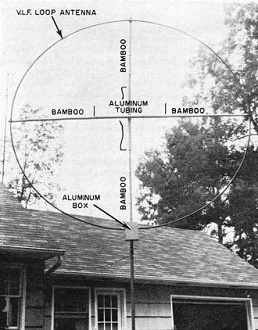
The author's loop must presently be turned by hand although it
is planned to install an antenna rotator for it shortly.
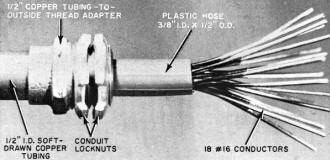
One end of the loop just prior to its being tied into the box.
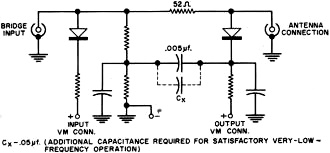
Fig. 4 - An s.w.r. bridge modification for improved v.l.f.
use.
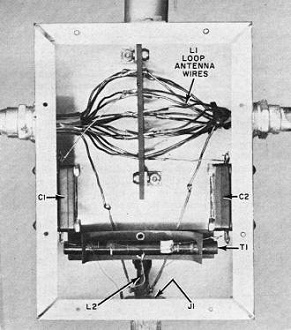
Inside view of the aluminum box. A terminal board or a piece
of insulating material with holes drilled into it can be used to support the connected
ends of the No. 16 loop antenna wires.
The first step in the construction of the loop proper is uncoil and stretch out
the 25 feet of copper tubing on a level floor. The straighter the tubing the easier
it will be to pull through the plastic hose and wires in the following steps. After
the tubing has been straightened, solder a 1/2-inch copper tubing-to-outside thread
adapter to each end of the tubing. Conduit nuts of suitable size may be used to
secure the copper tubing to the metal box which houses the smaller circuit components.
Next, measure to the exact center of the length of tubing and, using a tubing cutter,
cut the tubing in half. Keeping the tubing sections together, insert a 27-foot length
of plastic hose into one end of the tubing and, by working it slowly, pass the hose
through both sections of the tubing so that approximately one foot of hose remains
outside each end of the copper tubing.
At this point a single #16 wire should be worked through the tubing-hose combination
to facilitate pulling through the bundle of 18 #16 loop wires. The loop wires should
be cut to a length of 27 feet and each wire tinned on one end. The bundle of eighteen
wires should then be soldered to the pulling wire and the bundle carefully pulled
through the entire length of the loop tube. Incidentally, the tedious job of removing
the insulation from the wire ends can be simplified by using some Sears, Roebuck
No. 2779 Paint and Varnish Remover. The simplest way to form the loop is to layout
a circle 8 feet in diameter on your basement or garage floor. Use a heavy marking
pencil so the outline may be easily seen. A word of caution, don't construct the
loop in the basement if you can't get it out of the basement doorway.
In bending the tubing the author found that the 100 or so pounds of his 13-year-old
son standing on the tubing prevented the tubing from moving as the circle was being
formed. After the circle has been formed the plastic hose and wire should be cut
back as shown in the photograph. Suitable holes may now be drilled in the metal
box and the tubing ends fastened to the box with the conduit nuts.
A terminal board was installed in the metal box in order to facilitate connecting
the 36 wire ends into a continuous loop of 18 turns. Connecting the wires properly
can be accomplished by using an ohmmeter or they can be "buzzed out" by use of a
dry cell and buzzer or pilot light bulb. If care is exercised the center turn of
the multi-turn loop can be identified and marked at the time that the loop wires
are being soldered together to form the continuous coil thus avoiding the trouble
of trying to determine the loop center by electrical measurement. The loop wire
resistance is quite low, approximately 1 3/4 ohms, and it is quite difficult to
make accurate measurements in the low resistance range of the ordinary ohmmeter.
After the loop wires are all connected, except for the two ends, tuning coil L2
can be mounted and connected in series with the loop wires at the midpoint. Capacitors
C1 and C2 can be mounted and wired except for the connection to be made to the matching
transformer T1. A suggested layout for the various components that are installed
within the metal box is shown in the photograph.
Line-matching transformer T1 is an important part of the loop circuit in that
it provides the impedance transformation required while maintaining loop balance.
Reasonable care should be exercised in winding T1. The ferrite rod from a transistor-radio
loopstick was used as the core for this transformer. The original windings were
removed and 180 turns of #28 enameled wire close-wound on the core. This winding
will be the secondary and will connect to the coaxial output connector J1. To determine
how much wire will be required for the primary and how much space will be taken,
wind 104 turns of #28 enameled wire over the secondary. Remove the 104 turns of
wire and after finding the center of this length of wire, fold the length of wire
in half so that the wire is doubled. Now take the doubled wire and wind 52 turns
over the 180-turn secondary. Care should be taken to center the primary winding
over the secondary in order to maintain balance. By connecting the wires of the
primary as shown in Fig. 2 we will have a bifilar primary which will have equal
capacities from its ends to ground. Some coil dope can be applied to the windings
of T1 keep the wires in place. When the line-matching transformer has been completely
fabricated it should be installed in the metal box and wired into the loop circuit.
The loop antenna proper is now electrically complete and should be mounted in
a manner convenient to the builder. The author used a combination of aluminum tubing,
bamboo, and TV-type antenna clamps to construct the supporting cross members. Be
careful not to use a solid metallic framework to support the loop since the electrical
operation of the loop may be seriously affected by shorting across the electrostatic
shield. A piece of steel tubing was used for the lower part of the mast and this
piece of tubing was inserted into a slightly larger piece of tubing which had been
driven in the ground. As shown in the photograph of the loop, the "Armstrong" method
of rotating the loop was used; however, the author plans to install a TV antenna-type
rotator in the near future.
Tuning and Impedance Matching
Tuning the loop to resonate at a particular frequency in the 14 kc. to 25 kc.
range is not much of a problem. It is accomplished in the same manner as tuning
and impedance matching of higher frequency antenna systems. A simple block diagram
of the set-up used by the author is shown in Fig. 3. The standing-wave-ratio
bridge used for adjustments is a home constructed bridge typical of those described
in any of the popular radio handbooks. The audio signal generator used was a Heathkit
AG-9 with a range of up to approximately 100 kc.
Before starting the adjustment procedure it would be wise to check the bridge
to be used for satisfactory operation on the very-low frequencies. If the bridge
is to be used to check a 52-ohm termination, connect a 52-ohm resistor to the output
or line side of the bridge and feed a signal of about 20 kc. into the bridge. If,
with the correct load, the bridge indicates reflected signal, make the modification
to your bridge as shown in Fig. 4. The bridge should then operate satisfactorily
on the v.l.f. band.
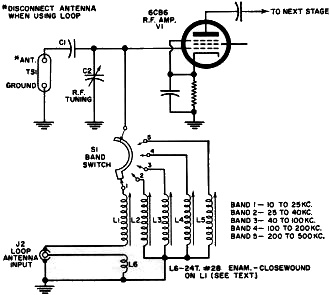
Fig. 5 - Circuit modification to the author's v.l.f. converter.
With the bridge and signal generator connected to the antenna, as shown in Fig. 3,
set the generator to deliver output at the frequency to which the loop antenna is
to be resonated. Adjust the loop tuning coil L2 until the reflected power reading
on the bridge reads a minimum. On the author's installation it was possible to obtain
a zero reading of reflected power on the bridge at all frequencies between 14 and
25 kc.
Impedance matching to the converter or receiver with which the loop antenna is
to be used can be accomplished in a number of ways. A satisfactory match to the
author's converter was made by winding 24 turns of #28 enameled wire on the converter
v.l.f. coil L1, as shown in Fig. 5. The coupling loop is wound as close as
possible to the original winding and on the slug adjustment side of the coil. The
converter v.l.f. coil was remounted on the upper side of the chassis since it was
found that a noticeable amount of signal strength was lost by under-the-chassis
mounting. The same mounting hole was used and several smaller holes were drilled
in the chassis to accommodate the grid and coupling coil connections which were
run under the chassis. In addition, a u.h.f.-type coaxial connector was installed
on the chassis to connect to the loop antenna transmission line.
For the different input impedances which may be encountered one may find it convenient
to use one of the ultra-compact high-fidelity audio transformers manufactured by
UTC. The UTC type A-24 or A-26 has a response of from 20 to 40,000 cycles with a
primary impedance of 15,000 ohms and 30,000 ohms respectively. The secondary impedance
for both of these transformers is 50, 125-150, 200-250, 333, and 500-600 ohms as
required. By using either one of these transformers in reverse it is possible to
make a transformation between the low impedance 52-ohm line and the high-input impedance
of a converter or receiver.
Another alternative in obtaining a higher feedpoint impedance for the loop antenna
is to replace capacitors C1 and C2 and line-matching transformer T1 with a single
.015-μf. capacitor to close the loop coil. When the loop is resonated by the
use of tuning coil L2 one may tap at two points, one on either side of the loop
electrical center and each equidistant from the center, and obtain a balanced feedpoint
that is higher in impedance than 52 ohms. On the author's loop, tapping of the first
two loop turns on either side of center gave a feed point impedance of 150 ohms.
This impedance could conveniently fed by the use of two 75-ohm coaxial cables with
the shields tied together and the inner conductors connected -one each to each loop
tap. Since the loop turns are accessible in the miscellaneous components box it
is quite convenient to tap in this manner to find a satisfactory feedpoint.
Operation and Results
Operation of the v.l.f. loop antenna needs very little comment. You will notice,
after a trial "spin," that the loop exhibits two very sharp nulls broadside to the
plane of the loop and that you have a much improved signal-to-noise ratio. Comparative
checks can be made which will vividly demonstrate the superiority of the loop over
that random long wire that you may now be using.
Stations now being heard by the author on the v.l.f. band include the U. S. Navy's
precise frequency-controlled transmitters such as NAA at Cutler, Maine on 14.7 kc.,
NBA (Summit, Canal Zone) 18 kc., NPG/NLK (Jim Creek, Washington) 18.6 kc. and others.
WWVL, the National Bureau of Standards' frequency-standard station, which operates
on 20 kc. from Sunset, Colorado can be heard but not nearly as loud as the Navy
"giants" which run in the neighborhood of two million watts of power to their antennas.
Several foreign stations, such as GBR in Rugby, England on 16 kc. and FUB near Paris,
France on approximately 17 kc., are being heard consistently. Future plans for the
very-low frequencies include the construction of a new Navy transmitter to be located
in Australia which will undoubtedly be in the multi-megawatt class and a proposed
NATO station which will operate on 19 kc. Recent tests using satellites have disproven
the belief that the ionosphere was a shield for the very-low frequencies with the
result that consideration is now being given to the use of these frequencies for
communicating between earth and outer space. The ultra-low frequencies recently
produced some astounding results when a 400 cycle-per-second signal was transmitted
a distance of approximately 750 miles from Boron, California to El Paso, Texas in
tests conducted by the Air Force.
The very-low and low frequencies are, to be sure, more fascinating than ever
before. Constructing the novel v.l.f. antenna described in this article will assure
you of greater success and listening pleasure while exploring the very-low frequencies.
Posted October 10, 2023
(updated from original post
on 8/4/2015)




































